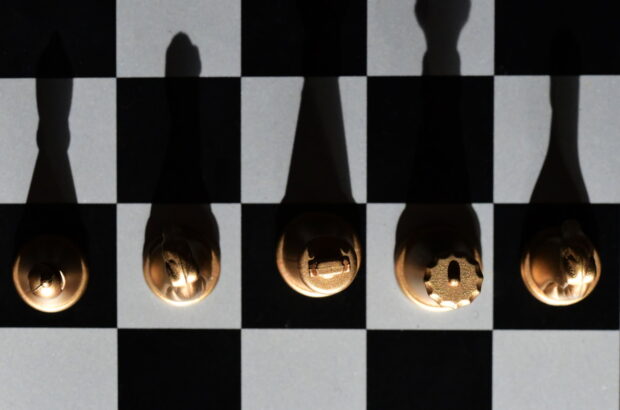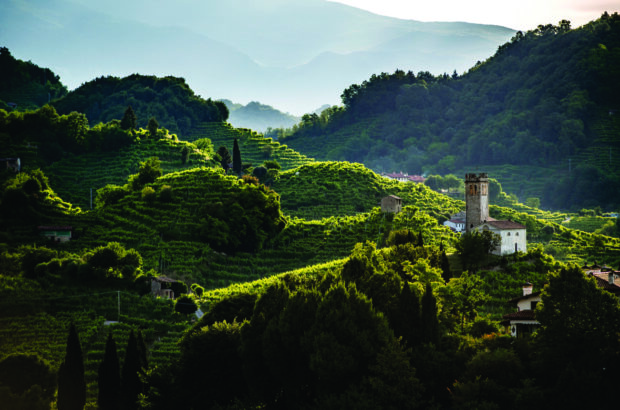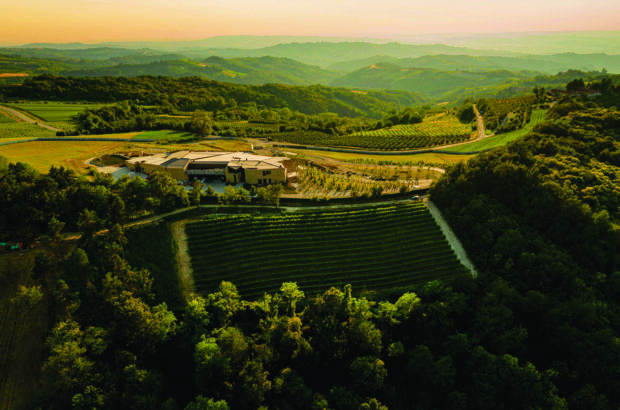Barolo may be known for its great wine, but the line between traditional and the contemporary methods of producing it is anything but fine, writes STEPHEN BROOK
On a recent visit to one of Barolo’s finest producers, Mauro Mascarello, I was taken aback when he fished out an email I had sent him months earlier, commenting on his top wine, Cà d’Morissio. My comment had been favourable, and had concluded with the assertion that the old distinction between ‘traditional’ and ‘modernist’ producers of Barolo was losing its importance. Mascarello is a high priest of the traditionalist wing, and he took polite exception to being lumped in with other fine winemakers whose approach was very different. My attempt at lordly arbitration had clearly not gone down well.
This was a vivid reminder that the debate is, in some eyes, very much alive. Traditionalists see themselves as the guardians of authentic Barolo, the outcome of a long, slow vinification followed by prolonged ageing in large, oak casks. Modernists, by and large, favour shorter macerations and more overt fruitiness, and often use barrique ageing to give the wine its structure and additional flavours.
Mascarello’s gripe against the modernists can be summed up as follows: ‘I don’t, for one minute, dispute that some modernists are making great wines. But they are not making great Barolo.’ Elio Altare, a pioneer among the modernists, once told me: ‘I’m not interested in making great Barolo. I simply want to make great wine. And all the world’s great red wines are matured in barriques.’
I have sympathies with both camps, which are both betrayed by their excesses. Poor traditionalists produce volatile, astringent and often dried-out wines with ferocious tannins; mediocre modernists swamp the complex aromas and fruit of the Nebbiolo grape with toasty, chocolatey, new oak flavours. Yet few would dispute that there are brilliant winemakers in both these opposed schools.
{"content":"PHA+T2YgYWxsIHRoZSByZWQgZ3JhcGVzIGluIHRoZSB3b3JsZCwgTmViYmlvbG8gbXVzdCBiZSB0aGUgbW9zdCB0cmlja3kgdG8gdmluaWZ5LiBQYWxlIGluIGNvbG91ciwgeWV0IGhpZ2ggaW4gdGFubmluLCBhY2lkaXR5IGFuZCBhbGNvaG9sLCBpdCBkZW1hbmRzIGEgZGlmZmljdWx0IGJhbGFuY2luZyBhY3QgZnJvbSB0aGUgd2luZW1ha2VyLiBTaG91bGQgb25lIGVsZW1lbnQgb2J0cnVkZSBleGNlc3NpdmVseSwgdGhlIHdpbmUgd2lsbCBiZSB1bmJhbGFuY2VkLiBDYWxpZm9ybmlhIHdpbmVtYWtlcnMgb2Z0ZW4gdGFsayBhYm91dCDigJh0YW5uaW4gbWFuYWdlbWVudOKAmS4gVGhlaXIgc3RydWdnbGUgd2l0aCB0aGUgZ2VuaWFsIENhYmVybmV0IFNhdXZpZ25vbiBpcyBub3RoaW5nIGNvbXBhcmVkIHdpdGggdGhlIGJhdHRsZSB1bmRlcnRha2VuIGJ5IEJhcm9sbyBhbmQgQmFyYmFyZXNjbyBwcm9kdWNlcnMgaW4gdGFtaW5nIHRoZSB0YW5uaW5zIG9mIE5lYmJpb2xvLjwvcD4KPHA+T25lIG9mIHRoZSBtYWpvciBkaWZmZXJlbmNlcyBiZXR3ZWVuIHRoZSB0d28gY2FtcHMgbGllcyBpbiB0aGVpciBhcHByb2FjaCB0byBtYWNlcmF0aW9uIOKAkyB0aGF0IGlzLCB0aGUgYW1vdW50IG9mIHRpbWUgdGhlIGp1aWNlIHJlbWFpbnMgaW4gY29udGFjdCB3aXRoIHRoZSBza2lucyBhbmQgcGlwcyBkdXJpbmcgZmVybWVudGF0aW9uLiBUcmFkaXRpb25hbGlzdHMgc3VjaCBhcyBNYXVybyBNYXNjYXJlbGxvLCBoaXMgbmFtZXNha2UsIHRoZSBsYXRlIEJhcnRvbG8gTWFzY2FyZWxsbywgb3IgdGhlIGxhdGUgR2lvdmFubmkgQ29udGVybm8gdGhvdWdodCBub3RoaW5nIG9mIGEgbWFjZXJhdGlvbiBvZiAzMCBkYXlzIG9yIG1vcmUuIEluZXZpdGFibHksIHRoaXMgd2lsbCBleHRyYWN0IG1vcmUgdGFubmlucyB0aGFuIGEgYnJpZWZlciBwZXJpb2QuPC9wPgo8cD7igJhCdXQgSSBrbm93IGhvdyB0byBjb21wZW5zYXRlIGZvciB0aGlzLOKAmSBleHBsYWlucyBNYXNjYXJlbGxvLiDigJhJIHBpY2sgdGhlIGdyYXBlcyB2ZXJ5IHJpcGUg4oCTIHNvbWV0aW1lcyBhIGxpdHRsZSBvdmVyLXJpcGUg4oCTIHNvIGFzIHRvIGF2b2lkIGJpdHRlciB0YW5uaW5zIGZyb20gdW5kZXJyaXBlIHBpcHMuIEFuZCBJIGFnZSB0aGUgd2luZSBmb3IgYSBsb25nIHRpbWUgaW4gbGFyZ2UgY2Fza3MgYmVmb3JlIGl0IGlzIHJlYWR5IGZvciBib3R0bGluZy4gVHJhZGl0aW9uYWwgQmFyb2xpIGxpa2UgbWluZSBkb27igJl0IHNob3cgd2VsbCB3aGVuIHlvdW5nLCBzbyB0aGV5IG9mdGVuIHN1ZmZlciBpbiBibGluZCB0YXN0aW5ncy48L3A+CjxkaXYgY2xhc3M9ImFkLWNvbnRhaW5lciBhZC1jb250YWluZXItLW1vYmlsZSI+PGRpdiBpZD0icG9zdC1pbmxpbmUtMyIgY2xhc3M9ImlwYy1hZHZlcnQiPjwvZGl2PjwvZGl2Pgo8cD7igJhUaGUgYWR2YW50YWdlIG9mIGEgdHJhZGl0aW9uYWwgdmluaWZpY2F0aW9uIGlzIHRoYXQgeW91IGRvbuKAmXQgZ2V0IGFyb21hcyBvZiB2YW5pbGxhIGFuZCBjaG9jb2xhdGUsIGFuZCB0aGUgZnJ1aXQgaXNu4oCZdCBtYXNrZWQgd2l0aCB3b29kIGZsYXZvdXJzLiBCYXJyaXF1ZS1hZ2VkIHdpbmVzIGNhbiBlYXNpbHkgdGlyZSB0aGUgcGFsYXRlLiBXaXRoIGEgc2hvcnQgbWFjZXJhdGlvbiwgdGhlIHF1YWxpdHkgb2YgdGhlIHRhbm5pbnMgZG9lc27igJl0IG1hdHRlciwgYnV0IHdpdGggbG9uZywgdHJhZGl0aW9uYWwgdmluaWZpY2F0aW9uLCB0aGF0IHF1YWxpdHkgaXMgY3J1Y2lhbC7igJk8L3A+CjxwPkNsZWFybHksIE1hc2NhcmVsbG8ga25vd3Mgd2hhdCBoZSBpcyBkb2luZywgYXMgZG8gb3RoZXIgdHJhZGl0aW9uYWxpc3RzIHN1Y2ggYXMgQnJ1bm8gR2lhY29zYSwgQWxkbyBWYWpyYSBhbmQgdGhlIENvbnRlcm5vcy4gQnV0IG1hbnkgdHJhZGl0aW9uYWxpc3Qgd2luZXMgd2VyZSBhd2Z1bC4gQ2xhdWRpbyBGZW5ub2NjaGlvLCBhbHNvIGEgdHJhZGl0aW9uYWxpc3QsIGV4cGxhaW5lZCBob3csIDQwIHllYXJzIGFnbywgdGhlIHdpbmUgY291bGQgYmUgc28gdG91Z2ggdGhhdCBpdCB3b3VsZCBiZSB0YWtlbiB1cCB0byB0aGUgYXR0aWMgaW4gZGVtaWpvaG5zIGR1cmluZyB0aGUgYmFraW5nIHN1bW1lcnMsIHNvIGFzIHRvIGFjY2VsZXJhdGUgdGhlIGV2b2x1dGlvbiBvZiB0aGUgb3RoZXJ3aXNlLXVuZHJpbmthYmxlIHdpbmUuIFRoZSB1c2Ugb2Ygb2xkIGNhc2tzIGNvdWxkLCBpZiBub3Qgc2NydXB1bG91c2x5IG1haW50YWluZWQsIHJhZGljYWxseSBpbmNyZWFzZSB0aGUgcmlzayBvZiBiYWN0ZXJpYWwgY29udGFtaW5hdGlvbjsgdm9sYXRpbGUgYWNpZGl0eSB3YXMgYW4gZXZlci1wcmVzZW50IHByb2JsZW0uPC9wPgo8ZGl2IGNsYXNzPSJhZC1jb250YWluZXIgYWQtY29udGFpbmVyLS1tb2JpbGUiPjxkaXYgaWQ9InBvc3QtaW5saW5lLTQiIGNsYXNzPSJpcGMtYWR2ZXJ0Ij48L2Rpdj48L2Rpdj4KPHA+SSBoYXZlIGhhZCB0aGUgZHViaW91cyBwbGVhc3VyZSBvZiB0YXN0aW5nIG1hbnkgdHJhZGl0aW9uYWwgQmFyb2xpIGZyb20gdGhlIDE5NjBzIGFuZCAxOTcwcywgYW5kIGEgY2xlYXIgbWFqb3JpdHkgaGF2ZSBub3QgYWdlZCB3ZWxsLiBPbiB0aGUgY29udHJhcnksIHRoZXkgZXhoaWJpdCBleHRyZW1lIHZvbGF0aWxpdHksIGRyeSB0YW5uaW5zLCBhIGxhY2sgb2YgZnJ1aXQsIGFuZCBvZmYtZmxhdm91cnMuPC9wPgo8cD5TbyBpdCBpcyBub3QgaGFyZCB0byB1bmRlcnN0YW5kIHdoeSB0aGUgbW9kZXJuaXN0IHBpb25lZXJzIOKAkyBFbGlvIEFsdGFyZSwgRG9tZW5pY28gQ2xlcmljbywgUm9iZXJ0byBWb2VyemlvLCBBbmdlbG8gR2FqYSwgdGhlIGxhdGUgUmVuYXRvIFJhdHRpLCBhbmQgb3RoZXJzIOKAkyB3ZXJlIGtlZW4gdG8gbWFrZSBhIGJyZWFrIGZyb20gdGhpcyBkdWJpb3VzIHBhc3QuIFRoZWlyIHZveWFnZXMgdG8gQnVyZ3VuZHkgYW5kIEJvcmRlYXV4IHBlcnN1YWRlZCB0aGVtIG9mIHRoZSB2aXJ0dWVzIG9mIHNob3J0ZXIgdmluaWZpY2F0aW9ucyBhbmQgYmFycmlxdWUgYWdlaW5nLiBJbmRlZWQsIFJhdHRpIGFyZ3VlZCB0aGF0IHRoZSBzby1jYWxsZWQgdHJhZGl0aW9uYWwgbWV0aG9kcyB3ZXJlIGFuIGFiZXJyYXRpb24sIGJyb3VnaHQgb24gYnkgbGFib3VyIHNob3J0YWdlcyBkdXJpbmcgcGVyaW9kcyBvZiB3YXIgYW5kIGVjb25vbWljIGNyaXNpcy4gVGhlIHRydWx5IHRyYWRpdGlvbmFsLCBidXQgbGFib3VyLWludGVuc2l2ZSwgcHJhY3RpY2Ugb2YgYnJlYWtpbmcgdXAgdGhlIGNhcCBoYWQgYmVlbiByZXBsYWNlZCBieSBtYWludGFpbmluZyB0aGUgY2FwIHN1Ym1lcmdlZCwgb2Z0ZW4gd2VpZ2hlZCBkb3duIGJ5IHN0b25lcywgdGh1cyBpbmV2aXRhYmx5IG1heGltaXNpbmcgdGFubmluIGV4dHJhY3Rpb24sIHdoaWNoIGluIHR1cm4gcmVxdWlyZWQgbG9uZyBhZ2VpbmcgaW4gY2Fza3MuPC9wPgo8ZGl2IGNsYXNzPSJhZC1jb250YWluZXIgYWQtY29udGFpbmVyLS1tb2JpbGUiPjxkaXYgaWQ9InBvc3QtaW5saW5lLTUiIGNsYXNzPSJpcGMtYWR2ZXJ0Ij48L2Rpdj48L2Rpdj4KPHA+VGhlcmUgY2FuIGJlIGxpdHRsZSBkb3VidCB0aGF0IHRoZSBtb2Rlcm5pc3QgcGlvbmVlcnMgcmV2b2x1dGlvbmlzZWQgdGhlIG1ha2luZyBvZiBCYXJvbG8gb3V0IG9mIGEgZ2VudWluZSBkZXNpcmUgdG8gaW1wcm92ZSBxdWFsaXR5LiBFbnJpY28gU2Nhdmlubywgd2hvIGVtcGxveXMgYm90aCBjYXNrcyBhbmQgYmFycmlxdWVzLCBpbnNpc3RzIGhlIGlzbuKAmXQgYWZ0ZXIgb2FreSBmbGF2b3Vycy4g4oCYSSB1c2UgYmFycmlxdWVzIGJlY2F1c2UgdGhleSBtYWtlIGl0IGVhc2llciB0byBmaXggdGhlIGNvbG91ciBhbmQgYW50aG9jeW5hbmlucywgYW5kIGdpdmUgdGhlIHdpbmVzIHNvbWUgbmVjZXNzYXJ5IG1pY3JvLW94aWRhdGlvbizigJkgaGUgc2F5cy4g4oCYQWxsIG9mIHRoaXMgaGVscHMgc2V0IHRoZSB3aW5lIG9uIHRoZSByaWdodCBwYXRoLiBUaGVuIGl0IGlzIGFnZWQgaW4gRnJlbmNoLW9hayBib3R0aSwgd2hpY2ggYXJlIG5ldXRyYWwgY29udGFpbmVycy4gSWYgeW91IHVzZSBub3RoaW5nIGJ1dCBiYXJyaXF1ZXMsIHRoZSBldm9sdXRpb24gb2YgdGhlIHdpbmUgaXMgbW9yZSByYXBpZC4gQnV0IHRoYXTigJlzIHByZWNpc2VseSB3aHkgSSByZXN0cmljdCBteSB1c2Ugb2YgYmFycmlxdWVzIOKAkyBJIHdhbnQgYSBzbG93IGV2b2x1dGlvbi7igJk8L3A+CjxwPlNjYXZpbm\/igJlzIG1ldGhvZHMgaWxsdXN0cmF0ZSB3aHkgdGhlIGRlYmF0ZSBpcyBieSBubyBtZWFucyBjbGVhci1jdXQuIEhlIGlzIG5laXRoZXIgYSBjYXJkLWNhcnJ5aW5nIHRyYWRpdGlvbmFsaXN0IG5vciBhIG1vZGVybmlzdC4gSW5zdGVhZCwgaGUgaXMgYW4gaW50ZWxsaWdlbnQsIHNlbnNpdGl2ZSB3aW5lbWFrZXIsIHdobyBib3Jyb3dzIHRob3NlIHRlY2huaXF1ZXMgdGhhdCwgaW4gaGlzIHZpZXcsIGNvbnRyaWJ1dGUgdG8gZ3JlYXRlciBxdWFsaXR5LCB3aGlsZSBkaXNjYXJkaW5nIG90aGVycy48L3A+CjxwPlRoaXMgaXMgd2hhdCBjaGFyYWN0ZXJpc2VzIHRoZSBvdXRzdGFuZGluZyBCYXJvbG8gcHJvZHVjZXJzLCBvZiB3aG9tIGhlIGlzIGluZGlzcHV0YWJseSBvbmUuIEVsaW8gR3Jhc3NvIGFnZXMgaGlzIGNydSDigJhSdW5jb3TigJkgaW4gbmV3IG9haywgYnV0IGhpcyBvdGhlciBCYXJvbGkgYXJlIGFnZWQgaW4gYm90dGksIHdoaWNoIGFyZSByZW5ld2VkIGV2ZXJ5IDEwIHllYXJzLiBSZW5hdG8gQ2lnbGl1dHRpIGluIEJhcmJhcmVzY28gYWxzbyB2YXJpZXMgdGhlIGtpbmQgb2Ygd29vZCBhY2NvcmRpbmcgdG8gdGhlIGNoYXJhY3RlciBvZiBoaXMgZGlmZmVyZW50IGNydXMuIERvbWVuaWNvIENsZXJpY28gaW5zaXN0cyBoZSBpcyBhIHRyYWRpdGlvbmFsIHByb2R1Y2VyLCBkZXNwaXRlIGhpcyB1c2Ugb2YgYmFycmlxdWVzLiBIaXMgQmFyb2xpIGFyZSBtYWNlcmF0ZWQgZm9yIDE4IHRvIDI1IGRheXMsIHlldCB0aGV5IGFyZSBhbHNvIGFnZWQgaW4gOTAlIG5ldyBvYWsgZm9yIGF0IGxlYXN0IHR3byB5ZWFycy4g4oCYVGhlIG9ubHkgcmVhc29uIEkgYW0gc2VlbiBhcyBhIG1vZGVybmlzdCBpcyBiZWNhdXNlIEkgaW5zdGFsbGVkIHRlbXBlcmF0dXJlIGNvbnRyb2wgYmVmb3JlIG1hbnkgb3RoZXJzLOKAmSBoZSBzYXlzLiDigJhNeSBtb3N0IGltcG9ydGFudCByb2xlIGlzIHRvIHJlc3BlY3QgYW5kIGV4cHJlc3MgbXkgZGlmZmVyZW50IHRlcnJvaXJzLCB3aGljaCBoYXZlIGJlZW4ga25vd24gZm9yIGNlbnR1cmllcyBieSBvdXIgYW5jZXN0b3JzLiBJbnRlbGxpZ2VudCBncm93ZXJzIG1hdHRlciBtb3JlIHRoYW4gY2xldmVyIHdpbmVtYWtlcnMu4oCZPC9wPgo8cD5Ud2VudHkgeWVhcnMgYWdvLCBDbGVyaWNvIHdhcyByZWdhcmRlZCBhcyBhIGZpcmVicmFuZC4gVG9kYXksIGhlIHNlZXMgaGltc2VsZiBhcyBhIGNvbnNlcnZhdGl2ZS48L3A+CjxwPlRoZXJlIGFyZSBwcm9kdWNlcnMgYW5kIHdpbmVzIHRoYXQgYXJlIHVuYXNoYW1lZGx5IG1vZGVybiwgc3VjaCBhcyB0aGUgbmV3LW9ha2VkIOKAmEVucmljbyBWSeKAmSBmcm9tIENvcmRlcm8gZGkgTW9udGV6ZW1vbG8sIGFuZCB0aGUgdGhyZWUgQmFyb2xpIGZyb20gQ29udGVybm8gRmFudGlubywgYWxsIGFnZWQgaW4gbmV3IG9hay4gTWFueSBncm93ZXJzIGluIExhIE1vcnJhLCBhcmRlbnQgZGlzY2lwbGVzIChhbmQgb2Z0ZW4gbmVpZ2hib3Vycykgb2YgQWx0YXJlLCBmb2xsb3cgaGlzIHByZWZlcmVuY2UgZm9yIHJhcGlkIHZpbmlmaWNhdGlvbiBpbiByb3RvLWZlcm1lbnRlcnMgYW5kIGJhcnJpcXVlIGFnZWluZy48L3A+CjxwPkZlZGVyaWNvIENlcmV0dG8sIG5vdCBhIHRyYWRpdGlvbmFsaXN0LCB0YWtlcyBhIGRpbSB2aWV3IG9mIHRoaXMgcmF0aGVyIGZvcm11bGFpYyBhcHByb2FjaC4g4oCYSXTigJlzIGVhc3kgdG8gbWFrZSBzby1jYWxsZWQgbW9kZXJuIHdpbmVzLOKAmSBoZSBzYXlzLiDigJhZb3UgZG8gc2hvcnQgbWFjZXJhdGlvbnMgYXQgaGlnaCB0ZW1wZXJhdHVyZXMsIHVzdWFsbHkgaW4gcm90by1mZXJtZW50ZXJzIGZvciBtYXhpbXVtIGNvbG91ciwgYW5kIHlvdSB1c2UgbG90cyBvZiBuZXcgb2FrLuKAmSBIZSBpbXBsaWVzIHRoYXQgdGhvdWdoIHRoZSByZXN1bHRpbmcgd2luZXMgbWF5IGJlIHBlcmZlY3RseSBnb29kLCB0aGV5IGFyZSB1bmxpa2VseSB0byBleHByZXNzIHRoZSBudWFuY2VzIG9mIHRlcnJvaXIuIEkgc2hhcmUgc29tZSBvZiB0aGF0IHNjZXB0aWNpc20sIGVzcGVjaWFsbHkgd2hlbiBpdCBjb21lcyB0byBBbHRhcmXigJlzIHRyZWFzdXJlZCBzaG9ydCBtYWNlcmF0aW9ucy4gSXQgc2VlbXMgc2lnbmlmaWNhbnQgdG8gbWUgdGhhdCBubyB0b3AgcHJvZHVjZXJzIGluIEJ1cmd1bmR5IG9yIEJvcmRlYXV4IOKAkyBiZW5jaG1hcmtzIGZvciBtb2Rlcm5pc20g4oCTIGhhdmUgYWRvcHRlZCB0aGUgdGVjaG5pcXVlLjwvcD4KPHA+SSBhcnJpdmUgYXQgbm8gY29uY2x1c2lvbiwgZXhjZXB0IHRoYXQgSSB3ZWxjb21lIHRoZSB2YXJpZXR5IGFuZCBxdWFsaXR5IG9mIHRoZSBwcmVzZW50LWRheSB3aW5lcyBmcm9tIEJhcm9sbyBhbmQgQmFyYmFyZXNjby4gSSBjYW4gdGFrZSBncmVhdCBwbGVhc3VyZSBmcm9tIGEgY29tcGxleCwgdHJhZGl0aW9uYWwgQmFyb2xvIGZyb20gdGhlIGxpa2VzIG9mIE1hc2NhcmVsbG8sIENvbnRlcm5vLCBGZW5ub2NjaGlvLCBDYXZhbGxvdHRvIG9yIEdpYWNvc2EsIHdpdGhvdXQgaXQgc3BvaWxpbmcgbXkgYXBwcmVjaWF0aW9uIG9mIHRoZSByaWNobHkgc3RydWN0dXJlZCwgYmFycmlxdWUtYWdlZCB3aW5lcyBmcm9tIHRoZSBtb2Rlcm5pc3QgY2FtcC4gQ29uc3VtZXJzIGFyZSBhbGwgdGhlIHJpY2hlciBmb3IgdGhlIGNob2ljZSBvZiBzdHlsZXMgbm93IGF2YWlsYWJsZS48L3A+CjxwPkl0IGlzIGFsc28gd29ydGggdW5kZXJsaW5pbmcgdGhhdCBvbmx5IGF0IHRoZSBleHRyZW1lIGVuZHMgb2YgZWFjaCBzdHlsaXN0aWMgd2luZyDigJMgdGhlIG5hbWVzIG9mIE1hdXJvIE1hc2NhcmVsbG8gYW5kIEVsaW8gQWx0YXJlIOKAkyBhcmUgZW50cmVuY2hlZCBwb3NpdGlvbnMgbWFpbnRhaW5lZC4gTW9zdCB3aW5lbWFrZXJzIGhlcmUgYXJlIHByYWdtYXRpc3RzLCBib3Jyb3dpbmcgYW5kIGFkYXB0aW5nIGZyb20gYW5jaWVudCBhbmQgbW9kZXJuIGlkZWFzLiBJbiBCYXJiYXJlc2NvLCB0aGUgZHluYW1pYyBHaW9yZ2lvIFBlbGxpc3Nlcm8gYWdlcyBoaXMgcmVndWxhciBCYXJiYXJlc2NvIGluIG9sZGVyIGJhcnJpcXVlcyBhbmQgaW4gYm90dGksIHdoZXJlYXMgaGlzIHRvcCBjcnUsIFZhbm90dSwgaXMgYWdlZCBlbnRpcmVseSBpbiBuZXcgb2FrLiBWaWV0dGkgYWxzbyB1c2VzIGJvdGggYmFycmlxdWVzIGFuZCBib3R0aS4gQWxkbyBWYWpyYSBmYXZvdXJzIGEgbGVuZ3RoeSBtYWNlcmF0aW9uIGFuZCBwcm9sb25nZWQgYWdlaW5nIGluIGJvdHRpLCBidXQgaGUgYWxzbyB1c2VzIHB1bXBvdmVycyBhbmQgbWVjaGFuaWNhbCBwdW5jaC1kb3ducywgd2hpY2ggd291bGQgcHJvYmFibHkgY2F1c2Ugc29tZSB0cmFkaXRpb25hbGlzdCBleWVicm93cyB0byByYWlzZS4gUm9iZXJ0byBWb2VyemlvIHVzZXMgYSBsb3Qgb2YgbmV3IG9haywgYnV0IGhpcyBmZXJtZW50YXRpb25zIGFyZSBxdWl0ZSBsb25nLiBJbiBzaG9ydCwgdGhlIHdpbmVtYWtpbmcgdGVjaG5pcXVlcyBhcmUgYWRhcHRlZCB0byB0aGUgc3RydWN0dXJlIG9mIHRoZSB3aW5lcy48L3A+CjxwPk5vdCBsb25nIGFnbywgdGhlIG9lbm9sb2dpc3QgRG9uYXRvIExhbmF0aSB3cm90ZSB0byBNYXVybyBNYXNjYXJlbGxvIGluIHN1cHBvcnQgb2YgaGlzIHRyYWRpdGlvbmFsaXN0IGFwcHJvYWNoLiBMb25nIG1hY2VyYXRpb25zLCBoZSBjb25maXJtZWQsIHdpbGwgZXh0cmFjdCBncmFwZS1zZWVkIHRhbm5pbnMsIHdoaWNoIHRoZXJlZm9yZSBuZWVkIHRvIGJlIHJpcGU7IGFuZCB0aGVyZTwvcD4KPHA+bWF5IGFsc28gYmUgc29tZSBsb3NzIG9mIGNvbG91ci48L3A+CjxwPkhlIGNvbmNsdWRlZCwg4oCYVGhpcyB3aW5lIHdpbGwgcGVyaGFwcyBiZSBzb21ld2hhdCBsZXNzIGNvbmNlbnRyYXRlZCwgd2l0aDwvcD4KPGRpdiBjbGFzcz0iaW5qZWN0aW9uIj48L2Rpdj4KPHA+YSBsaXR0bGUgbGVzcyBjb2xvdXIgYW5kIHNsaWdodGx5IG1vcmUgdGFubmluLCBidXQgaXQgd2lsbCBiZSBtb3JlIGRpc3RpbmN0aXZlLCBtb3JlIGVsZWdhbnQsIG1vcmUgYXV0aGVudGljLCBhbmQgaXQgbWF5IGV2ZW4gYmUgYSBsaXR0bGUgbW9yZSDigJx0cnVlIHRvIGl0cyByb290c+KAnSwgYXMgd2Ugd291bGQgbGlrZSBhbGwgb3VyIHJlbGF0aW9ucyB3aXRoIGxpZmUgdG8gYmUu4oCZPC9wPgo8cD5JIGZpbmQgdGhpcyB0byBiZSBwZXJzdWFzaXZlIGFuZCBlbG9xdWVudCwganVzdCBhcyBJIGFtIHBlcnN1YWRlZCBieSB0aGUgdGhvdWdodGZ1bG5lc3MgYW5kIHBhc3Npb24gZm9yIHF1YWxpdHkgb2YgYSBDbGVyaWNvIG9yIFNjYXZpbm8uPC9wPgo8cD4K"}












